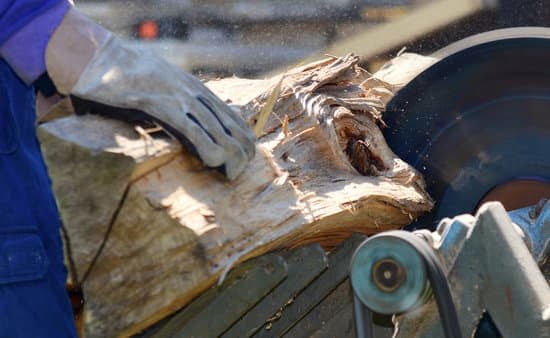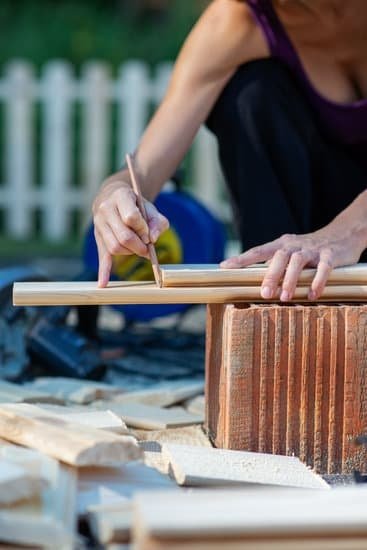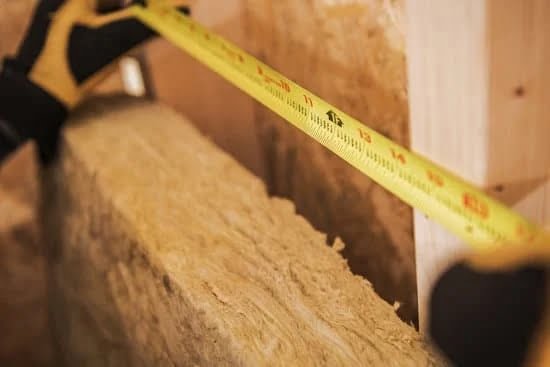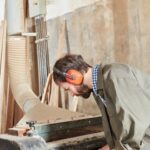Woodworking is a craft that requires precision and attention to detail. Every cut, joint, and measurement plays a crucial role in achieving a flawless final result. One aspect of woodworking that often goes overlooked but can make or break a project is marking interference. In this article, we will delve into the world of marking interference in woodworking and explore its importance in ensuring accurate and high-quality results.
When two pieces of wood come together, they need to fit snugly without any gaps or misalignment. This is where marking interference comes into play. By accurately identifying areas where the wood pieces are interfering with each other, woodworkers can ensure proper fitting joints, seamless connections, and overall stability of the final structure.
While it may seem like a minor step in the woodworking process, neglecting to mark interference can lead to disastrous consequences. Imagine spending hours meticulously crafting intricate joinery or constructing an elegant piece of furniture only to find that the pieces don’t fit together as planned due to unmarked interference. It not only results in wasted time and effort but also compromises the structural integrity and aesthetic appeal of your work.
In the upcoming sections of this article, we will dive deeper into the concept of interference in woodworking. We will discuss its various forms and causes, introduce essential tools for marking interference accurately, provide step-by-step techniques to mark interference effectively, address common challenges faced by woodworkers, explore precision measurements for accurate marking, offer specific strategies for different projects, troubleshoot potential issues that may arise during the process, and share tips for effective interference marking.
Whether you are a novice woodworker or an experienced craftsman looking to refine your skills further, this comprehensive guide will equip you with the knowledge needed to mark interference like a pro. So let’s get started.
Understanding Interference
Interference is a critical concept in woodworking that directly influences the final result of any project. It refers to the unwanted contact or overlap between two or more pieces of wood that can compromise the integrity and aesthetic of the finished piece. Understanding interference is crucial for woodworkers as it enables them to identify and address potential issues before they become irreversible problems.
In woodworking, interference comes in various forms. One common type is when two or more pieces of wood do not fit together properly due to inaccurate measurements, improper joinery techniques, or misaligned cuts. This can result in uneven gaps, misaligned edges, or joints that are too loose or too tight. Additionally, interference may also manifest as parts of wood rubbing against each other during assembly or when moving components within a larger structure.
Several factors can cause interference in woodworking projects. Inaccurate measurements and inconsistent dimensions play a significant role in creating interference. Small variations in measurements can accumulate and lead to misalignment and unfitting joints. Other causes include errors in layout and marking, imprecise cutting techniques, warping or twisting of the wood due to moisture content changes, and inadequate planning during the design phase.
By understanding the various forms and causes of interference in woodworking, craftsmen can take proactive steps to achieve precise results. They must pay close attention to their measurements, ensuring accuracy by using reliable tools like rulers, calipers, and marking gauges mentioned earlier in this article. Careful planning is essential to avoid errors during layout and marking stages. Woodworkers should also invest time in selecting appropriate joinery techniques for each project to reduce the risk of interference later on.
Overall, understanding interference is vital for every woodworker as it helps ensure that their projects are structurally sound, visually pleasing, and functional. By being aware of the different forms and causes of interference detailed above, craftsmen can implement strategies early on to minimize challenges throughout the woodworking process.
Essential Tools for Marking Interference
When it comes to accurately marking interference in woodworking projects, having the right tools is crucial. These tools not only help measure and mark precise dimensions but also ensure that the final result is free from any unwanted interference. Here are some essential tools that every woodworker should have in their toolkit to effectively mark interference:
- Rulers: Rulers are a fundamental tool for measuring and marking lengths, widths, and depths in woodworking. They come in various materials such as metal or wood and are available in different lengths. For accuracy, it is important to choose a ruler with clear markings and edges that allow for easy alignment.
- Calipers: Calipers are indispensable when it comes to measuring small distances precisely. These handy tools can measure external dimensions (outside calipers) or internal dimensions (inside calipers). By adjusting the legs or jaws of the calipers, woodworkers can easily transfer accurate measurements onto their workpieces.
- Marking Gauges: Marking gauges play a vital role in accurately transferring dimensions and lines onto wood surfaces. They typically consist of a beam with an adjustable marker or blade that slides along it. The blade can be set at the desired measurement and then used to scribe lines on the wood surface, ensuring consistent markings throughout the project.
In addition to these essential tools, there are other useful instruments such as squares, bevel gauges, and compasses that can also aid in marking interference accurately. It is important to invest in quality tools that are durable and provide precise measurements to achieve superior results in woodworking projects.
| Tool | Description |
|---|---|
| Rulers | A fundamental tool for measuring and marking lengths, widths, and depths in woodworking. |
| Calipers | Indispensable for measuring small distances precisely, available in different types for external and internal measurements. |
| Marking Gauges | Used to transfer dimensions and lines accurately onto wood surfaces through scribing. |
Having these essential tools in your woodworking arsenal will allow you to mark interference more accurately, leading to better-fit joints and precise woodworking projects overall.
Techniques for Marking Interference
Woodworking requires precision and accuracy, especially when it comes to marking interference. Properly marking interference ensures that the different woodworking pieces fit together perfectly, resulting in a high-quality finished product. In this section, we will discuss step-by-step instructions for various techniques to mark interference accurately.
One common technique for marking interference is scribing. To use this method, you will need a scribe or a sharp-pointed tool. Start by holding the scribe against one piece of wood and pressing it down firmly while moving along the joint where the two pieces will meet.
The scribe will create a small groove or line on the surface of the wood, indicating where material needs to be removed for a proper fit. Repeat this process on all pieces that need to be joined together.
Another effective technique for marking interference is dovetail marking. Dovetail joints are commonly used in woodworking projects like drawers and cabinets. To mark interference for dovetail joints, you’ll need a dovetail marker or template. Place the marker against one piece of wood and trace around its edges with a pencil or knife, creating precise markings for cutting out the dovetails. Repeat this step on all corresponding pieces to ensure an accurate fit.
Knife lines are yet another reliable method for marking interference in woodworking. This technique involves using a sharp knife to score lines on the wood’s surface where two pieces will intersect. These knife lines provide clear markers indicating which areas need to be removed or adjusted for an optimal fit. Use a ruler or straight edge to guide your knife along the desired lines and make sure not to cut too deeply into the wood.
By utilizing these techniques – scribing, dovetail marking, and knife lines – you can accurately mark interference in your woodworking projects. These step-by-step instructions enable you to identify problem areas and make necessary adjustments before assembling your pieces together, resulting in well-fitted and professional-looking finished products.
Common Interference Challenges
One of the biggest challenges faced by woodworkers when it comes to marking interference is accurately identifying and marking the areas where interference occurs. Interference can take various forms in woodworking, such as gaps between joints, misaligned edges, or parts that don’t fit together properly. These issues can have a significant impact on the final result of a woodworking project, leading to ill-fitting joints or a lack of structural integrity.
To overcome these challenges, woodworkers need to develop a keen eye for spotting potential interference points and effectively marking them for adjustment. Here are some common interference challenges that woodworkers often encounter and solutions on how to identify and mark them accurately:
- Gaps in Joints: One common challenge is dealing with gaps that occur between joints. This can be caused by inaccurate measurements, improper cutting techniques, or dimensional changes in the wood due to changes in humidity. To identify these gaps, woodworkers can run their fingers along the joint or use a ruler to check for any inconsistencies. Once identified, the gap can be marked using a pencil or knife line precisely.
- Misaligned Edges: Another common interference challenge is when edges do not align properly. This can make it difficult to join pieces together securely and may also affect the overall appearance of the project. Woodworkers can use rulers or calipers to measure the alignment of edges and mark any discrepancies with a pencil or knife line. This will help them accurately adjust and align the edges for a better fit.
- Parts That Don’t Fit Together Properly: Sometimes, certain parts of a project may not fit together as intended due to incorrect measurements or errors during assembly. Woodworkers should carefully inspect each part for any mismatched dimensions or irregularities before attempting to join them together. If an interference is found, it can be marked using scribing techniques or knife lines before making necessary adjustments.
By understanding these common interference challenges faced by woodworkers and learning how to identify and mark them accurately, woodworkers can ensure that they achieve precise and well-fitting joints in their woodworking projects. These marking techniques will help improve the overall quality and appearance of the final product, making for a successful and satisfying woodworking experience.
Precision Measurements
Achieving precision in woodworking is crucial for ensuring a high-quality final result. One key aspect of achieving precision is through accurate measurements, especially when it comes to marking interference. Precision measurements not only help woodworkers identify potential areas of interference but also enable them to make precise adjustments and cuts to ensure a perfect fit.
In order to achieve accurate measurements, woodworkers should be familiar with the different tools and methods available. One commonly used tool for measuring interference is a ruler or tape measure. These tools provide a quick and convenient way to measure distances and dimensions accurately. It is essential to use a ruler that has clear markings and is made from a sturdy material to avoid any errors.
Another useful tool for precise measurements in woodworking is calipers. Calipers come in various forms, such as dial calipers or digital calipers, and they allow woodworkers to take precise inside, outside, or depth measurements. By using calipers, woodworkers can ensure that their interference markings are based on accurate measurements, leading to better-fitting joints and connections.
A marking gauge is another essential tool for achieving precision measurements in woodworking. This tool enables woodworkers to set specific distances or depths for marking lines accurately on their workpiece. By adjusting the marking gauge according to the required measurement, woodworkers can consistently mark interference at the desired locations, resulting in more precise cuts and assemblies.
To summarize, precision measurements play a significant role in marking interference accurately in woodworking projects. Woodworkers should invest in high-quality measuring tools like rulers, calipers, and marking gauges to ensure accuracy. By understanding the significance of precision measurements and utilizing appropriate tools and techniques, woodworkers can significantly enhance the quality of their work by minimizing interference issues.
| Tool | Function |
|---|---|
| Ruler | Quick and convenient way to measure distances and dimensions accurately. |
| Calipers | Allow for precise inside, outside, or depth measurements. |
| Marking Gauge | Enables accurate marking of specific distances or depths on workpieces. |
Marking Strategies for Different Projects
Woodworking projects can vary greatly in terms of size, complexity, and purpose. This means that different projects require specific marking strategies to ensure accurate interference marking. It is essential for woodworkers to understand the unique considerations and techniques for marking interference in various types of projects like cabinetry, furniture making, and joinery.
Cabinetry
Cabinetry typically involves the construction of cabinets, shelves, and storage units. When marking interference in cabinetry projects, it is crucial to consider the overall dimensions of the space where the cabinet will be installed. Start by measuring the exact height, width, and depth of the designated area to ensure a precise fit. Use rulers or measuring tapes to mark these dimensions accurately on your workpiece.
In addition to overall measurements, cabinetry often requires marking specific areas for hinges, handles, or shelving supports. Take into account the placement and size requirements for these elements when marking interference. Use specialty tools like a mortise gauge or hinge templates to mark these areas precisely.
Furniture Making
Furniture making involves crafting tables, chairs, beds, or other pieces of functional or decorative furniture. To mark interference accurately in furniture making projects, start by studying the design plans or blueprints to understand how all the components fit together. Identify any areas where multiple pieces will intersect or connect.
Consider using a combination square or sliding bevel to mark angles and ensure that angled joints fit perfectly together without gaps or misalignments. If you are working with curved surfaces such as chair legs or table edges, use flexible rulers or contour gauges to capture accurate measurements and contours when marking interference.
Joinery
Joinery refers to the process of connecting two or more pieces of wood together securely. Whether you are creating dovetails, mortise and tenon joints, or box joints in joinery projects, precision marking is crucial for a seamless fit. Use a marking gauge or marking knife to create clear and accurate reference lines and edges.
For projects involving complex joinery, consider making test joints using scrap wood to ensure the accuracy of your interference markings before working on the final pieces. This will allow you to make any necessary adjustments or corrections without compromising the quality of the final product.
By tailoring your marking strategies according to the specific requirements of each woodworking project, you can ensure that interference is marked accurately and achieve superior results. Understanding the unique considerations and techniques for cabinetry, furniture making, and joinery will help you approach these projects with confidence and precision.
Troubleshooting Interference
Common Issues in Interference Marking
When marking interference in woodworking, there are several potential issues and errors that can arise. Understanding and troubleshooting these problems is crucial to ensure accurate and precise markings. Here are some common challenges woodworkers may encounter during the interference marking process:
Inaccurate Measurements
One of the most common issues in interference marking is inaccurate measurements. This can occur due to various factors such as using improper measuring tools, not taking into account the expansion or contraction of wood, or human error in reading measurements.
To overcome this problem, it is essential to use reliable measuring tools suitable for woodworking, such as rulers, calipers, or tape measures specifically designed for accuracy in carpentry. Additionally, double-checking measurements and considering any environmental or material factors that may affect the final dimensions will help achieve precision in interference marking.
Visible Marks
Another challenge that woodworkers may face while marking interference is leaving visible marks on the surface of the wood. This can occur when using incorrect techniques or applying excessive force during marking. To prevent visible marks on the wood, it is crucial to employ gentle pressure and control while using tools like scribes or knives. It is also advisable to practice on scrap pieces of wood before working on a final project.
Misalignment of Joints
Misalignment of joints can often be a result of inaccurate interference marking. This issue arises when the marked lines do not align properly with corresponding parts during assembly. To troubleshoot this problem, it is essential to carefully reevaluate and compare joint markings before assembling them together. Double-checking alignment based on multiple reference points can help identify any discrepancies early on and make adjustments accordingly.
Troubleshooting Techniques
To overcome these potential issues and errors during interference marking in woodworking, here are some troubleshooting techniques:
Triple-Check Measurements
To ensure accurate measurements, it is recommended to measure multiple times using different tools and cross-reference the results. This triple-checking approach can help eliminate measurement errors and provide precise values for marking interference.
Use Light Pressure
When marking interference, apply light pressure using scribes or knives to avoid leaving visible marks on the wood surface. Gradually increase pressure only if necessary to achieve deeper markings, ensuring that it does not affect the aesthetics of the final project.
Fine-Tune Joint Alignment
If misalignment of joints occurs during assembly due to incorrect markings, carefully evaluate the joint fit and make any necessary adjustments before proceeding further. This may involve modifying marking lines or reworking the affected areas to ensure proper alignment.
By identifying common issues and implementing these troubleshooting techniques, woodworkers can overcome challenges during interference marking in woodworking, resulting in more accurate and successful projects.
Tips for Effective Interference Marking
In order to ensure accurate and efficient marking of interference in woodworking, there are several key tips and best practices that woodworkers should keep in mind. These tips can not only enhance the overall quality of the final result but also make the process smoother and more effective.
Firstly, it is important to have a proper understanding of the different types of interference and their causes. By familiarizing themselves with common forms of interference such as gaps, overlaps, and mismatches, woodworkers can better identify and mark them accurately. Additionally, knowing the potential causes of interference, such as improper measuring or inaccurate cutting, can help prevent it from occurring in the first place.
Secondly, precision measurements are crucial when marking interference. It is essential to use reliable tools such as rulers, calipers, or marking gauges to achieve accurate measurements. Taking the time to double-check measurements before marking can save a lot of frustration down the line. Additionally, using various techniques for measuring angles and distances can help ensure precise markings.
Another important tip is to utilize appropriate marking techniques for different woodworking projects. Each project may require specific strategies and considerations when marking interference. For example, when working on cabinetry or furniture making projects where aesthetics play a significant role, using fine-tipped pencils or scribes for delicate lines can be beneficial. On the other hand, joinery projects may require more robust markings like knife lines or dovetail markers for accuracy.
Furthermore, it is crucial to regularly troubleshoot any potential issues or errors that may arise during the interference marking process. Common problems include inaccurate measurements due to worn-out tools or shifting pieces during layout work. By identifying these issues promptly and implementing troubleshooting techniques such as recalibrating tools or securing workpieces properly before marking, woodworkers can minimize errors and maintain accuracy.
By incorporating these key tips and best practices into their woodworking routine, craftsmen can greatly enhance the accuracy and efficiency of marking interference. With a thorough understanding of interference, precision measurements, appropriate marking techniques, troubleshooting methods, and project-specific strategies, woodworkers can achieve superior results in their woodworking projects.
Conclusion
In conclusion, marking interference is a crucial step in woodworking that greatly impacts the final result of any project. Throughout this blog post, we have explored the different forms and causes of interference and discussed essential tools and techniques for accurately marking it. We have also delved into common challenges faced by woodworkers and provided effective solutions to overcome them.
One important takeaway from this discussion is the significance of precision measurements in marking interference. By achieving accurate measurements using rulers, calipers, and marking gauges, woodworkers can ensure precise marks that enable them to achieve superior results. Additionally, we have provided specific marking strategies for different woodworking projects such as cabinetry, furniture making, and joinery.
It is important for readers to implement the techniques discussed in this blog post to enhance the accuracy and efficiency of their woodworking projects. By accurately identifying and marking interference, woodworkers can avoid costly mistakes and achieve professional-level craftsmanship. Remember to troubleshoot any potential issues that may arise during the interference marking process.
Frequently Asked Questions
How do you mark lines on wood?
To mark lines on wood, you can use a variety of tools depending on the precision and type of marking required. One common method is to use a pencil or pen to draw lines directly onto the wood surface. This is particularly useful for rough or approximate markings.
Another option is to use a combination square or try square, which allow for accurate measurements and perpendicular markings. These tools typically have a ruler or blade attached to them, allowing you to draw straight lines with ease. Additionally, you may utilize a marking gauge, which uses an adjustable fence or blade to create consistent parallel markings along the wood grain.
What do you use to mark wood for cutting?
When marking wood for cutting purposes, there are several tools that can be employed depending on the situation. A traditional choice is a carpenter’s pencil, which has a flat and wide lead suitable for making clear and visible lines on wood surfaces. Carpenter’s pencils often have an oblong shape to prevent rolling away and may come with additional features like integrated erasers or sharpeners.
For more precise marking, carpenters might use a marking knife. This tool consists of a sharp, pointed blade that can score thin lines onto the wood’s surface without any risk of tear-out when cutting across the grain.
What do carpenters use to mark wood?
Carpenters have various methods and tools at their disposal when it comes to marking wood accurately. Some commonly used instruments include layout squares such as combination squares or try squares which provide reliable 90-degree angles for marking cuts or joints precisely.
In addition to these basic measuring tools, carpenters often utilize marking gauges—a handy device that allows users to adjust the distance between the fence and a sharp pin or wheel—which aids in creating parallel lines during joinery work. Chalk lines are also popular among carpenters for long, straight marks as they allow one person to make extended measurements by snapping taut strings coated in colored chalk against the material being marked—the resulting line provides an easy-to-follow guide for cutting or shaping wood.

Hi everyone! I’m a woodworker and blogger, and this is my woodworking blog. In my blog, I share tips and tricks for woodworkers of all skill levels, as well as project ideas that you can try yourself.





